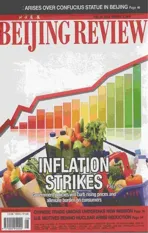Forecasts
2011-12-24
Forecasts
Ba Shusong, Deputy Director of the Research Institute of Finance at the Development Research Center of the State Council:
Since 2010, China has raised the reserve requirement ratio eight times and interest rates three times. It also cleared the financing vehicles of local governments and stepped up a stringent clampdown over the feverish property markets. Obviously, China is withdrawing from the stimulus policies adopted to counter the financial crisis and returning to normal policies. These measures could pour cold water on red-hot domestic demands and help moderate inflation. Meanwhile, stable supplies of vegetables and grain could also relieve some inflationary pressures.
After the Spring Festival holiday (February 2-8), vegetable prices have been dropping across the nation, and food price growth is also bound to slow. The recovery of the U.S. economy and price surges of international commodities will continue to fuel China’s inflation. But the CPI is less likely to spiral out of control since domestic demands are expected to weaken.
Labor cost increase and global grain price surges are driving up consumer prices in China. But this is not a problem for just 2011, but an overwhelming trend for the long term.
If follow-up policies are well implemented, the CPI will likely edge lower after peaking in January or February. The central bank is expected to take an array of measures this year like interest rate hikes. But it is less likely to take as aggressive moves as it did in the first two months of this year.
Frank Gong, Vice Chairman of China investment banking of J.P. Morgan:
As the Chinese economy picks up steam, the country has put its focus on managing inflationary risks.
Non-food price increases, like rent and wages, are drawing attention. As China seeks to boost consumption and lift domestic demands, the growth of residents’income may even outpace that of the GDP. Concerns are therefore bubbling that the gains in wages may lead to broader inflation.
However, rapid wages inflation in recent years has largely happened to the low-end labor markets in recent years. A large number of white-collar workers only experienced very mild income growth.
As a result, there is no need to worry over food-driven inflation since bad weather’s impact on food supplies is only temporary.
In the past few months, climbing global prices of agricultural products have pushed up domestic prices. But not all of China’s agricultural products are linked with overseas markets. The country relies on imports for barely 1 percent of its grain consumption. What may really drive up domestic grain prices this year is the drought in northern areas.
Food prices caused consumer inflation two times in the past—between 2003 and 2004, as well as between 2007 and 2008. But those two rounds of inflation lasted for only half a year.
So there is reason to believe that the current high level of inflation is only tem-porary, and the CPI will be controlled at around 4 percent this year. The rate may even slide below 4 percent in the latter half of 2011 as austerity measures gain traction.
Zhu Baoliang, chief economist of the State Information Center:
China’s inflation rate will peak in June, and then head south in the latter half of this year. As a result, a series of tightening monetary policies will be mostly announced in the first half of the year.
Two major factors are adding to China’s inflation jitters: quantitative easing policies of developed countries and price hikes of labor and land. In addition, excessive domestic liquidity and bad weather were also significant causes.
The Chinese economy will grow around 10 percent this year, with the consumption sector stabilizing and consumer prices on the rise. Food and raw material prices will experience a run-up, but land prices will not see a sharp tick-up.
The lagging effect of massive monetary expansion in the past two years will continue to provide strong tailwinds for inflation in the near term. The ongoing reforms to price systems of resources like water and electricity may add fuel to the inflationary jitters.
Ma Jun, chief economist at the Deutsche Bank, Greater China:
The January CPI grew slower than expected, but I’d like to raise my estimate for inflation rate of the entire year to 5 percent from the previous 4.4 percent. The peak will come in the second quarter at 6 percent. There are five reasons for the estimate.
First, the real economy is faring better than expected, which helped force up raw material and energy prices. This is attributable to an overly loose monetary environment.
The broad money supply soared nearly 20 percent in 2010 from a year ago, overshooting the government’s target of 17 percent. If policymakers set the target for this year at 16 percent, the growth rate is still too fast for an economy already reeling from inflation.
Second, costs inflation of raw material will ripple through the consumer market in the months to come. For example, cotton prices skyrocketed 86 percent last year, and garment prices are therefore set to creep up this year.
Third, rents are expected to accelerate growing in six to 12 months after house price surges.
Data from the National Bureau of Statistics showed prices of residential factors in the basket of CPI went up 6.8 percent year on year in January, much faster than other goods. The rents, in particular, gained 7.1 percent from the previous year.
Fourth, soaring wholesale prices of agricultural products will soon spread to the food processing sector. China reaped a bumper harvest of grain last year, and supply is not a problem. But excess liquidity is fuelling speculation. That is why it is necessary to cool the red-hot economy and tame monetary expansion.
Fifth, the expectations for inflation may quicken money flows and heighten inflationary fears. Fighting inflation has been a key to macroeconomic controls this year and it should be granted top priority over any other economic issues including maintaining growth.
